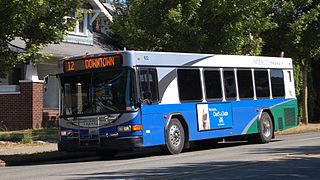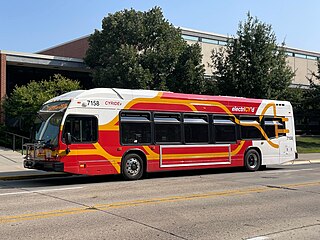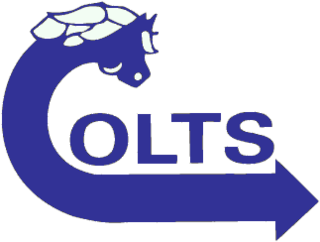
Unitrans is the transit system which operates in and around the campus of the University of California, Davis. It takes its name from an abbreviation of the words "University Transport". Excepting several managerial and maintenance positions, Unitrans is managed and operated entirely by students of the University of California, Davis who usually work part-time while attending school. The system is well known throughout the area for its use of several distinctive ex-Transport for London double-decker buses, as well as its fleet of modern natural gas single-decks. The system has 18 weekday, 1 school-centered and 6 weekend routes. Current fares are $1.25 for the general public and included in student fees for undergraduate University attendees. Unitrans is one of a small number of transit systems in the United States to operate double deck buses in regular (non-sightseeing) service. Unitrans has one of the best safety records of any public transit system in the US.

The Champaign–Urbana Mass Transit District is a mass transit system that operates in the Champaign–Urbana metropolitan area in eastern Illinois. MTD is headquartered in Urbana and operates its primary hub at the intermodal Illinois Terminal in downtown Champaign. In 2022, the system had a ridership of 7,797,100, or about 21,900 per weekday as of the second quarter of 2023.

Fairfax Connector is a public bus service provided by Fairfax County, Virginia, United States, and is managed by the county government. The bus system provides service within Fairfax County, and connects to Metrobus, Metrorail stations, Virginia Railway Express, and other local bus systems. Fairfax Connector serves all of Fairfax Metrorail Stations, the city of Alexandria, the city of Fairfax, the Washington Dulles International Airport, and the Pentagon Metrorail station. In 2022, the system had a ridership of 4,851,200, or about 29,400 per weekday as of the second quarter of 2023.
Clemson Area Transit, a zero-fare bus line known locally as CAT or the "CAT Bus", is the most frequently used transit system in South Carolina. Areas with bus service include Clemson University, the City of Clemson, the County of Anderson, City of Seneca and the Towns of Central and Pendleton. The fare-free system is made possible by federal grants and matching funds from the city and University. CAT operates a modern fleet of buses, including over 10 forty foot long Proterra electric buses, 7 forty foot long NOVA low-floor buses, and two sixty-two foot long articulated NOVA buses dubbed the "Caterpillars"- the first and only two articulated bus currently operated in South Carolina. In 2022, the system had a ridership of 731,300.

Metrobus is a bus service operated by the Washington Metropolitan Area Transit Authority (WMATA). Its fleet consists of 1,595 buses covering an area of 1,500 square miles (3,900 km2) in Washington, D.C., Maryland, and Virginia. There are 269 bus routes serving 11,129 stops, including 2,554 bus shelters. In 2022, the system had a ridership of 90,123,200, or about 350,700 per weekday as of the second quarter of 2023.

Ride on is the primary public transportation system in Montgomery County, Maryland. Managed by the Montgomery County Department of Transportation, Ride On serves Montgomery County as well as the community of Langley Park in Prince George's County and Sibley Memorial Hospital in Washington, D.C. In fiscal 2018, it operated on a US$112.3 million budget. In 2022, the system had a ridership of 13,848,200, or about 52,600 per weekday as of the second quarter of 2023.

Driving Alexandria Safely Home (DASH) is the public bus system for the city of Alexandria, Virginia, operated by the Alexandria Transit Company.

The Centre Area Transportation Authority (CATA) is a mass transit agency that provides bus transportation within State College, Pennsylvania and the surrounding areas, as well as Pennsylvania State University. In 2022, the system had a ridership of 4,305,500, or about 24,400 per weekday as of the second quarter of 2023.

Intercity Transit is a public transportation agency organized as a municipal corporation in Thurston County, Washington, United States. It serves Lacey, Olympia, Tumwater, and Yelm: an area of approximately 94 square miles (240 km2). It operates 21 bus routes, the Dial-A-Lift door-to-door service, a vanpool program, and specialized van programs.

Norwalk Transit is a municipal transit company providing fixed-route and paratransit bus transit services in Norwalk, California, United States, and also operates in portions of Artesia, Bellflower, Cerritos, La Habra, La Mirada, Santa Fe Springs and Whittier in southeast Los Angeles County and northwestern Orange County. In 2022, the system had a ridership of 851,800, or about 3,200 per weekday as of the second quarter of 2023.
Torrance Transit is a transit agency primarily serving the South Bay region of Los Angeles County. In 2022, the system had a ridership of 1,855,200, or about 6,800 per weekday as of the second quarter of 2023.
The Indianapolis Public Transportation Corporation, branded as IndyGo, is a public transit agency and municipal corporation of the City of Indianapolis in the U.S. state of Indiana. It operates fixed-route buses, bus rapid transit, microtransit, and paratransit services.

VINE Transit is a public transportation service in Napa County, California, United States; it is managed under the Napa Valley Transportation Authority and operated by Transdev. The system offers extensive service throughout the county along with providing connections to other public transportation systems in adjacent counties. In 2022, the system had a ridership of 484,600, or about 1,300 per weekday as of the second quarter of 2023.

CyRide is a partnership between Iowa State University, the ISU Student Government, and Ames, Iowa. CyRide provides public transportation to the community throughout the city of Ames. The word CyRide is a portmanteau of two words: Cy and the word ride. In January 2012, CyRide was recognized "as the nation’s small urban transit system with the highest number of rides per capita" at 106 rides per capita.

The Portage Area Regional Transportation Authority, commonly referred to as PARTA, is a transit agency serving Portage County, Ohio. It is headquartered in Franklin Township just outside the Kent city limits. PARTA was formed in 1975 from an agreement between the city of Kent and Franklin Township and has since expanded to include routes over much of Portage County. It operates several local routes including circulator and suburban routes in Kent, and an interurban route connecting Ravenna, Kent, and Stow. PARTA also offers express routes including services into downtown Cleveland, Akron as well as weekday service to the rural Portage County communities of Windham, Garrettsville and Hiram. In addition, PARTA includes Kent State University's Campus Bus Service, which it acquired in 2004, and a dial-a-ride service. A proposed plan to acquire Lorain County Transit to serve better bus service in Lorain County. In 2022, the system had a ridership of 633,800.

Berks Area Regional Transportation Authority (BARTA), previously Berks Area Reading Transportation Authority, is a public transportation system serving the city of Reading and its surrounding area of Berks County, Pennsylvania. The South Central Transit Authority owns BARTA and the Red Rose Transit Authority (RRTA). In 2022, the system had a ridership of 2,098,200, or about 8,600 per weekday as of the second quarter of 2023.

The County of Lackawanna Transit System (COLTS) is the operator of public transport for the city of Scranton urban area and its surrounding area of Lackawanna County, Pennsylvania. It began operations in 1972, largely using routes established by predecessor Scranton Transit. In 2022, the system had a ridership of 733,800, or about 2,700 per weekday as of the second quarter of 2023.

Lextran is a public transportation bus system serving Lexington, Kentucky. Lextran operates 25 bus routes throughout the city of Lexington. Buses converge at the Downtown Transit Center located at 220 East Vine Street. In 2022, the system had a ridership of 3,264,100, or about 11,400 per weekday as of the second quarter of 2023.

The Regional Transportation Commission of Washoe County (RTC) is the public body responsible for the transportation needs throughout Reno, Sparks and Washoe County, Nevada. The RTC, founded by the Nevada Legislature in 1979, is an amalgamation of the Regional Street and Highway Commission, the Regional Transit Commission and the Washoe County Area Transportation Study Policy Committee. They provide public transportation services, street and highway construction, and transportation planning. In 2022, the system had a ridership of 4,598,700, or about 16,100 per weekday as of the second quarter of 2023.

Transfort is the public transportation operator for Fort Collins, Colorado. The system offers 22 regular routes, with 20 of them providing all-day service Monday through Friday. Six-day intercity service is provided by the FLEX to Loveland, Berthoud, and Longmont. Additionally, five routes for transporting Colorado State University students, faculty and staff run throughout the school year. In 2022, the system provided transportation services to 1,753,800 people.




















